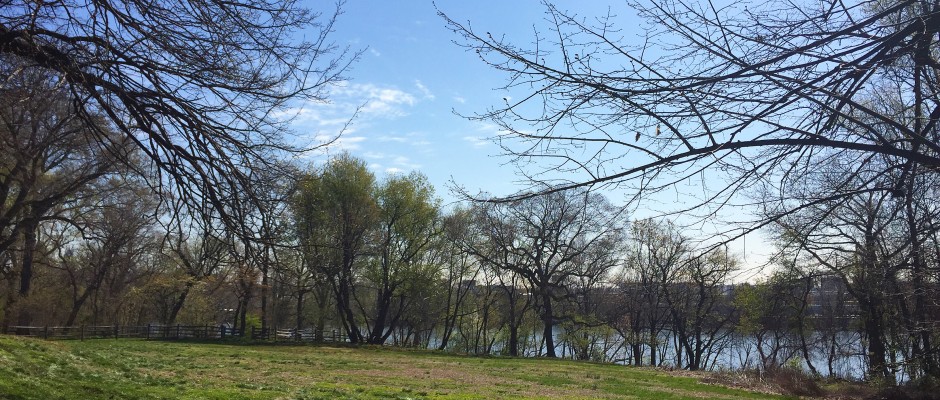Richard Louv calls it “Nature-Deficit Disorder.” Published a decade ago, his book Last Child in the Woods linked the absence of nature in the lives of children to rising rates of obesity, attention disorders and depression. Educators have been voicing their agreement: Nature preschools have been popping up all over the country and world, from the Seattle “preschool without walls” described in a recent New York Times article to “Forest Kindergartens” in Finland. Now, Philadelphia is coming on board thanks to a partnership between Smith Playground and the Delaware Valley Association for the Education of Young Children (DVAEYC).
Smith Memorial Playground and Playhouse, located in East Fairmount Park, has been a family favorite for 117 years. Today, the site embodies the same mission as when it opened: provide opportunities for kids to engage in free play in a free space open to everyone. Over 200,000 children and adults visited Smith last year, coming from over 500 zip codes, with North Philadelphia the biggest neighborhood represented.
After recent repairs and improvements to the site, the organization began looking forward.
“What else can we do in this space and what partners are there that we might work with to create something really important for kids and families?” Meg Wise, Smith’s Executive Director, recalls asking. “It was like a lightbulb. DVAEYC was a perfect partner for us.”
Delaware Valley Association for the Education of Young Children came on board and plans for the nature preschool were set into motion.
Nature preschools are defined by DVAEYC as having “an inquiry-based curriculum driven by children’s innate curiosity in nature.” Quality nature preschools use the outdoors as their classroom, employing natural materials in the environment to guide play and learning. While some iterations literally operate in the woods with no walls, many, like the vision for Smith, have both an indoor component and a natural outdoor space.
Roxborough’s Schuylkill Center for Environmental Education, now in their third year of offering a Nature Preschool program, is serving as a model for Smith.

“Our students are outdoors about half of their school day, sometimes more,” says Gail Farmer, the Schuylkill Center’s Director of Education, describing a typical day. “In the fall and spring, they often have morning meeting, snack and lunch outdoors, in addition to their regular time on field excursions and in the nature playscape.”
The teachers at the Nature Preschool view the environment as a tool, and use children’s discoveries and interests from their outdoor explorations to drive curriculum. Excitement over finding animal tracks in the snow, for example, might lead to math activities such as measuring or sorting by shape and size. The Center’s blog, Children Need Nature, highlights activities such as seed counting, environmental art projects and visiting the Center’s crab apple orchard.
For Brian Kuser, education director at the Fernbrook Farms Environmental Education Center in Chesterfield, N.J., the benefits of the preschool classes his organization offers are myriad.
“Having a nature preschool program provides a lot of learning opportunities where kids get to create their own outcomes and their own goals within nature,” he says. Building houses out of sticks in the woods, for example, offers more opportunities for creativity than “a predetermined worksheet that they get in the classroom.”
Activities range from forest scavenger hunts to chasing butterflies and insects in a meadow. Parents often tell Kuser how their children behave better later in the day and are generally happier and more positive after spending the day outdoors.
“Kids are getting not only the physical benefits of being outside and playing with nature,” explains Kuser, “but the social and emotional benefits are amazing to see and watch.”

Farmer, meanwhile, emphasizes the cognitive benefits: “Kids need nature — especially urban kids.” She explains that the natural world stimulates curiosity and emotions in a way difficult to replicate in any other environment. The sensory-rich, open-ended learning environment makes it “a learning context that really supports best practices in early childhood education.”
The theory might be the same across locations, but the specifics of the environment vary.
“The idea is that the natural environment is the driver for the curriculum,” explains Wise. “Kids go outside every day, they use the resources that the space presents, which could be very different if you’re in rural Minnesota versus Fairmount Park. Where we are — in the park, with the trail, with the watershed — all of the green assets right here inspire the curriculum in the school.”
Engaging the community and getting input from local families has already been an essential part of the process at Smith. The founders received help from Compass, a nonprofit that matches high-level volunteers with community-based nonprofit programs — that means lawyers and MBAs offering free advice on the school’s business model.
Smith is now launching a capital campaign.
“The price tag for all the things left is a very big price tag,” says Wise, “[That includes] restoration to the building and the space that would become the urban nature preschool.”
She refers to the project as an “Urban Nature” preschool, “because we want the families of North Philadelphia, who are so close to us, to really be the core audience for the preschool.”
The school plans to have with two classrooms for forty children ages 3-5 in a full-day, full-year program, with a financial model that serves a mixed constituency — some students will pay market price and others will be offered a subsidized rate.
“It’s really important to us that we serve families in North Philadelphia, but [the location is] also really convenient to people living in the suburbs or northwestern part of the city or the Main Line driving into Center City for work,” explains Wise.

The goal: an independent preschool drawing an audience that’s racially, economically, and geographically diverse.
While a few years of fundraising and construction are in order before the doors open, in the meantime, a new space in Smith’s playground called the Nature Explore area will offer small-scale nature programming. Philadelphia is the first city to receive a Nature Explore “outdoor classroom” space thanks to resources from the U.S. Forest Service. (The ribbon-cutting took place April 1.)
Wise sees the project as a way to engage local families by introducing them to the concept and starting the conversation about the importance of play in nature.
“When your kids are digging in the dirt or building a construction out of these tree branches, they are having some amazing cognitive processes happen in their heads,” she says. “This is really important and you should prioritize and create opportunities where your kid can do stuff like this.”
That “stuff” includes hopping across the stepping-stools of tree trunks, using a fallen log as a balance beam, and digging in the mud pit, all features of the Nature Explore space. There will also be a sand table and a water table; low surfaces ideal for building with blocks and loose parts; and a slate board for drawing on with shale rocks, nature’s chalk. The wood chips on the ground create a natural path (in place of the “safety surface” on other parts of the playground). Nearby, a line of willow trees touch branches, forming a tunnel.
“You can go through it if you’re small enough,” enthuses Wise.
What about convincing city parents that sending their child to a nature preschool is a good idea?
“We’re very aware that this is not a ‘build it and they will come opportunity,'” says Wise. “There are a lot of pressures on parents for what is the best preschool environment. I think it’s on us to help educate families and parents and teachers that this is a really important and successful model, and that it’s an antidote to all the stresses and challenges that four year olds face. It’s kind of wild to think, but, yeah, four year olds can be really stressed out.”
MARTHA COONEY is a Philly-based writer. She is founder and director of StoryUP!, which inspires kids to build literacy skills through comedy and storytelling.
This story originally ran in our sister publication Flying Kite Media. Follow all their work #OnTheGroundPhilly via twitter (@flyingkitemedia) and Instagram (@flyingkite_ontheground).
On the Ground is made possible by the Knight Foundation, an organization that supports transformational ideas, promotes quality journalism, advances media innovation, engages communities and fosters the arts. The foundation believes that democracy thrives when people and communities are informed and engaged. For more, visit knightfoundation.org.


